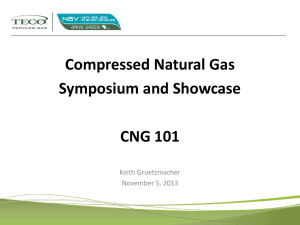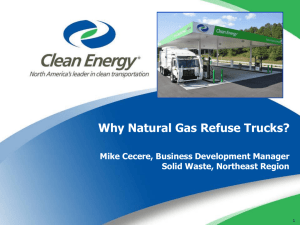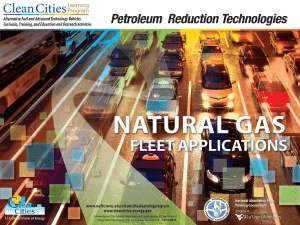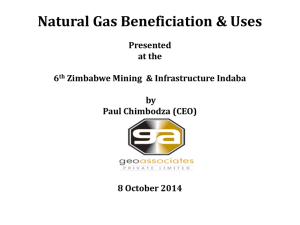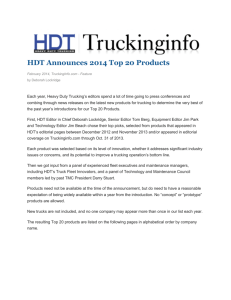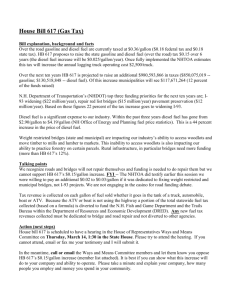Natural Gas in
advertisement
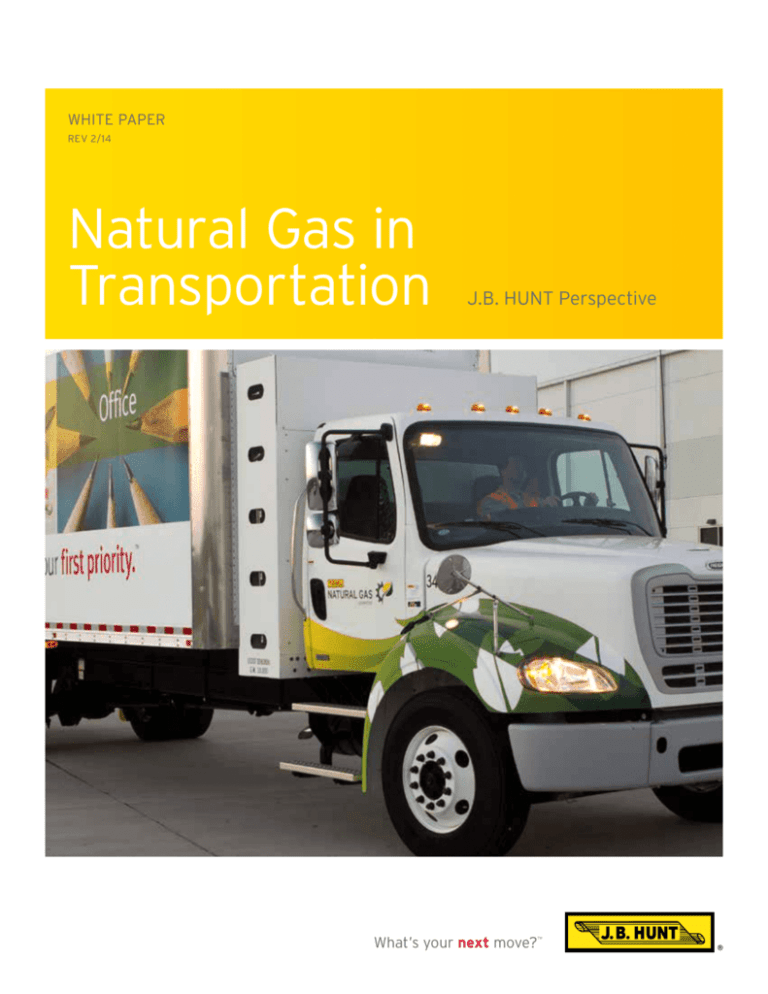
WHITE PAPER REV 2/14 Natural Gas in Transportation J.B. HUNT Perspective What’s your next move?™ General Position: We believe there will continue to be more and more natural gas tractors go into service in our industry in the near future. It is the right thing to do. It is American, it is clean, and it is abundant and cheaper than diesel. Having said that, there have been and continue to be major hurdles slowing down the adoption of natural gas (NG) vehicles in our industry. We are making progress on several fronts to overcome these concerns but some remain. The Truck Availability The 12 liter Cummins Westport engine is now available in truck models from practically all truck manufacturers. These trucks performed well in test throughout 2013 according to our industry contacts. Whereas the limited availability of the 12 liter NG engine in recent years inhibited carriers’ ability to incorporate natural gas vehicles into heavy duty fleets, this is no longer an obstacle. Orders for these trucks are now routinely placed and fulfilled in a timely manner. We continue to evaluate potential applications for this truck. Cost The incremental cost of the 12L tractor currently ranges from +$50,000 to +$90,000. This price range is highly dependent upon tank specifications, the primary factor in the range of increased cost. Tank packages range from $22,000 to $61,000 (this encompasses CNG and LNG tank packages for various range requirements). Even with large fuel price spreads this added cost remains difficult to overcome when combined with the other constraints later detailed. MPG The fuel economy penalty for natural gas trucks is one of the most significant hurdles to overcome. We currently observe an approximate 15% to 20% fuel mileage reduction on the 12L natural gas trucks. It is important to note that this quality of the natural gas engine ( primarily a result of it being spark ignited versus compression ignited) has become even more significant with the onset of SCR (selective catalytic reduction) trucks replacing EGR (exhaust gas recirculation) trucks to meet current EPA emission standards. SCR trucks are quickly replacing their EGR predecessors in our fleets. These trucks use DEF (diesel exhaust fluid) as an after-treatment method to reduce emissions. This method of emission reduction lends itself to greater fuel efficiency. So, whereas earlier natural gas conversion cost models compared EGR diesel trucks to natural gas trucks and showed MPG spreads in the 10% range, current models compare SCR diesel trucks to natural gas trucks and show MPG spreads in the 15-20% range. This MPG penalty of converting from diesel to natural gas is one of the most significant elements of the cost evaluation. Residual Value This is currently an unknown, and, thus another significant obstacle toward a positive ROI. Maintenance There is a serious lack of facilities equipped to repair any NG tractors especially LNG tractors (due to the venting). Our existing maintenance facilities would have to be retro-fitted in order to work on the NG tractors indoors. In order to meet the local fire department requirements, modifications can range between $50,000- $150,000 per bay, depending on the shop size and layout. In terms of operating costs, the spark ignited engine leads to higher costs, and fuel tank maintenance costs could be significant. Spark plugs must be replaced every 60,000 miles. So far, performance results and general industry discussion has the additional maintenance cost coming in between 2 and 4 cents per mile. The Fueling Infrastructure Regardless of perception, the simple fact is that the natural gas fueling infrastructure is still extremely limited and underdeveloped. That said, work is steadily being done to develop stations across the country. Clean Energy and Pilot Flying J are making progress with the development of ”America’s Natural Gas Highway” for Liquefied Natural Gas (LNG) users. Loves Travel Stops and others are sprinkling Compressed Natural Gas stations in certain areas. However, the vast majority of existing natural gas Natural Gas In Transportation White Paper REV 02/14 1 stations today are not accessible or equipped to handle heavy duty vehicles. We continue to evaluate the fuel network attributes and availability, as well as evaluate the viability of developing stations of our own. Most of the public access stations are not large enough to accommodate a class 8 tractor and trailer, nor do they have adequate compression to completely fill a large tractor within a reasonable amount of time. Building our own station is a concept we explore, but achieving an adequate return on that capital investment is also difficult to do at this time. Finding an adequate natural gas station to support an operation is usually the biggest obstacle we encounter on this topic today. Operational Impacts There is a weight and range penalty for converting to NG tractors and we should seriously consider a weight variance for tractors equipped with NG engines. This is a product of the difference in the efficiency of storing the various fuels. CNG tanks are significantly larger and heavier than diesel tanks for the same travel distance. LNG tanks are about 1.7 times the size of diesel tanks to hold the same amount of energy and add slightly more weight. On a comparable tractor, LNG adds approximately 0 -1,000 more lbs. to the tractor while CNG adds about 800-2,600 more pounds depending upon the desired range. Generally, as the need for more range increases, more space is consumed and more weight is added when using natural gas. The Fuels CNG or LNG? LNG can be $0.75 to $1.50 cheaper than diesel on a diesel gallon equivalent (DGE) basis. CNG can be $1.50 to $2.30 cheaper per DGE.* LNG is more expensive than CNG due to the cost to convert and transport the NG in a liquid form. LNG contains more energy in a smaller space than CNG making it easier to carry more energy onboard and have a smaller range and weight penalty than CNG. There are many different configurations of tank sizes for diesel, CNG and LNG. As a general rule, a diesel tractor with twin 100 gallon tanks will have a range of more than 1,200 miles. A CNG tractor with two 45 DGE tanks will have a range of approximately 390 – 440 miles depending on the tanks being filled by the “fast fill” or “slow fill” technique. The fuel tank is filled at a rate similar to diesel when utilizing “fast fill”. However, a complete fill is currently not possible when utilizing “fast fill” due the increase in pressure in the tank caused by heat being generated with such a fast fill rate. A “slow fill” (6-8 hours) allows for a more complete fill but obviously is only possible in return to base operations. A LNG truck with two 100 gallon tanks would have a range of about 500-550 miles. There is a weight and range penalty with both CNG and LNG as previously mentioned. Again, it all depends on the size of the tanks, which is dictated by the required mileage range. Generally, LNG is a lighter option than CNG, but both add weight. Which fuel (CNG or LNG) is the “best fit” for our industry? Our opinion on this has continued to evolve as we gain more and more information and experience. Early on it appeared that CNG was the fuel of choice for a local operation with a return to base set-up with a range of 350-400 miles. CNG can offer large fuel savings, especially if the “slow fill” option is a possible solution. And, it appeared that LNG was the best solution for a longer length of haul operation and has a smaller weight penalty. However, as two key elements continue to develop so does our opinion. Those elements are fuel network availability and CNG tank technology. With the lower price of CNG (compared to LNG) some groups are pushing to 2 J.B. Hunt Transport Services, Inc. develop a CNG infrastructure that would be more fitting to heavy duty fleets. Also, new tank manufacturers bringing competition and innovation to the marketplace are expected to present (in the near future) lighter weight, cheaper CNG tanks than those that are currently available. As the fuel network and tank technology develops, it is thought currently that CNG may very well compete with LNG as the type of natural gas fuel to “best fit” heavy duty trucking, especially given the cheaper price of CNG. We continue to assess. *Fuel price spreads are significantly affected by tax credits that may or may not be in effect, discussed in more detail later. Achieving the ROI – Putting It All Together These trucks are much more expensive than diesel trucks. The fuel is less expensive than diesel fuel. How does it all look on the scales? There are seven primary components that work in combination to paint the economic picture of a natural gas powered truck versus a diesel truck. > T ruck Cost >U tilization > R equired range >M ile Per Gallon > F uel price spread > R esidual >M aintenance costs Scenarios that we most commonly encounter are described here: 1) Highly utilized truck (100,000+ miles per year) usually using a more “spread out” fueling network, thus needing longer range. You can look for CNG stations to fit this kind of operation but will rarely find an adequate CNG network to make it work. Therefore, you are left with LNG as the fuel type, potentially using the Clean Energy/Pilot Flying J LNG station network (America’s Natural Gas Highway). In this scenario you have one positive and two negatives. The positive is a highly utilized truck to burn a lot of fuel and generate payback on the fuel spread. The negatives are that you need more range to get those miles, which means more tank cost, and you have to use LNG which only has about a 75 cent advantage to diesel. Then you have to overcome what is currently about $75,000 in incremental truck cost (for a truck requiring this kind of range). These components combine for a significantly negative ROI on a 5 year truck. 2) A lower utilized truck (45,000-60,000 miles per year) in a more local application, using a “home base” or central type fuel station. This means we can probably use CNG because we don’t need as much range between fueling and we only have to rely on one primary station, which may be easier to locate in certain markets (such as Southern California or within the Texas triangle). The positives here are that we get to use the lower priced CNG fuel (at around $1.50 below diesel), and don’t need as much fuel storage on the truck (so we’re not adding as much tank costs). And, it could be argued that the less expensive 9L engine truck could be used if this was a Final Mile type operation. The truck in this scenario may have an incremental cost of around $60,000. Without generating a lot of miles, this truck doesn’t burn enough fuel to generate payback, even on CNG price and a truck on the lower end of the added cost spectrum. These components combine for a negative ROI on a 5-6 year truck. Natural Gas In Transportation White Paper REV 02/14 3 The above are two general examples of applications commonly explored and the conclusion we would draw (negative ROI). 1) High miles to capitalize on fuel spread versus high truck cost and lower fuel spread. 2) Lower truck cost and lower fuel price vs. lower miles, thus, less opportunity to capitalize on fuel spread. Ideally, we’d like to be able to take advantage of a “sweet spot” between the two scenarios, but so far have not seen such a possibility. In all cases, the MPG disadvantage also impedes the ROI. Other Thoughts and Concerns Fuel Price Spread - While there has been a significant increase in the availability of NG, it is a volatile commodity. Since 2008 we have seen NG rage from $2-$13 mmbtu (million British Thermal Units) while oil has ranged from $40 - $147 bbl (barrel), with current pricing of $4.80 mmbtu and $100 bbl, respectively. Translated to an on-road, energy equivalent basis defined as a “DGE” (Diesel Gas Equivalent), since 2008 natural gas has ranged from $2.25 to $3.75 while diesel has ranged from $2.00 to $4.75. The current relative spread for CNG is around $1.50 (LNG will have a lower spread as explained earlier) It is unknown what the future prices of both natural gas and diesel will be as our country works through environmental issues with the fracking technology, the potential of exporting of LNG, availability of diesel with more US oil reserves, the impact of the Keystone Pipeline and potential expansion of Gas-toLiquid (GTL) plants. Taxes and Volumetric Excise Tax Credit (VETC) Important notes A significant part of what has given natural gas (both LNG and CNG) its price advantage over diesel is the federal tax credit known as the “VETC (Volumentric Excise Tax Credit).” This provides a 50 cent per GGE (Gasoline Gallon Equivalent) credit for the sale of CNG, and a 50 cent credit per liquid gallon of LNG. To put this in terms of diesel gallons equivalent, this equates to a 56 cent credit on CNG and an 85 cent credit on LNG. This credit has been in place through the end of 2013, however, it expired as of January 1, 2014. Our understanding is that this tax credit may likely be debated as time goes on (similar to a federal tax credit that has been in and out of play on biodiesel over the last decade, and it is possible that it could be reinstated, modified, discontinued again, etc., over time. The existence or modification of this credit in the future will significantly affect the economics of natural gas truck solutions. In addition to the credit, the Federal Excise Tax on LNG and CNG also needs to be understood. The issue here is that CNG is taxed on a per GGE basis and LNG is taxed on a per liquid gallon basis. When both are converted to diesel gallon energy equivalents CNG is “fairly” taxed but LNG is not. LNG currently carries a tax rate that is approximately 41 cents per gallon while CNG carries a 24 cents per gallon tax rate. This 17 cent disadvantage on LNG is expected to be corrected with a change to the LNG tax rate at some point in the future. 4 J.B. Hunt Transport Services, Inc. Understanding the effect of these two tax-related issues and their possible future is important in assessing the economics of a potential natural gas fleet. Current Conclusions and Position We continue to look into isolated opportunities for use of NG tractors in our Intermodal and Dedicated operations. We feel it works best in an “out and back” operation, or a fixed lane “book end” type of operation. We currently operate 4 NG tractors. Two of these are 9 liter engine trucks that were placed in our Final Mile delivery business in October of 2011. The other two are 12 liter engine trucks we have recently placed in a longer length of haul Dedicated operation in Texas. All four of these trucks operate on CNG. We continue to study the results of these tractors as we anxiously await performance results of the 12L engine, stay on the lookout for potential cost reduction opportunities for the NG tractor, and work with our industry partners for the aforementioned concerns (station availability, fuel economy, fuel price, fill times, weight addition, maintenance costs) to be addressed. In the meantime, we will move slowly, deliberately and cautiously in purchasing NG tractors. Further questions regarding J.B. Hunt’s natural gas vehicle program can be directed to: Jerrod Mounce Director of Fuel Management 479-361-7581 jerrod_mounce@jbhunt.com Natural Gas In Transportation White Paper REV 02/14 5 What’s your next move? ™ Contact us at 1-800-643-3622 or e-mail us at contact@jbhunt.com www.jbhunt.com
